

 | Just about everything in the US started with the venerable JN4, or "Jenny". The Curtis JN4 was built from a combination of the Curtis J and N trainers in 1914. The Jennys were first put into service in 1916. Over 10,000 Jennys were produced. After the first world war, the cheap and plentiful supply of JN4s gave the development of civil aviation a boost. Thousands of barnstormers travelled the country in Jennys introducing the public to flight. This aicraft is actually a Standard which is another of the seminal aircraft from the early days. This particular aircraft is now on display at the Henry Ford Museum in Dearborn Michigan. | |
| In some cases, military aviation spurred the further development of civil aviation through the availability of civilian variants of military craft. This not only helped make excellent craft available to the public but also helped the aircraft companies to stay solvent through supplementing their government income. This aircraft is Milo Burcham's "Blue Flash" civilian version of the Boeing P-12-A. In this craft, Burcham won the International Aerobatic Championship. The P-12 was one of the first fighters with a fuselage of light metal alloy. It was a high performance fighter used by both the Army and the Navy. | 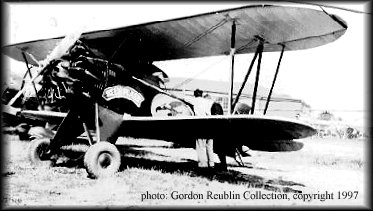 | |
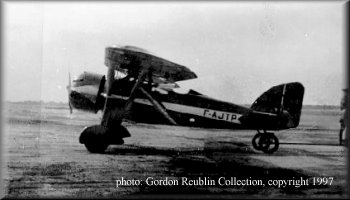 | Of course other countries had blossoming aviation industries too. This French Moraine Saulnier Parasol is one of the greatest aircraft ever to come out of Europe. The model 230 was a popular aircraft during the period 1930 to 1939. Besides use as a civil aircraft, this high wing monoplane was originally developed for the military as a trainer. | |
| Much of the development of aviation was fostered by corporations who had some stake in its success. The large oil companies were huge supporters of aviation and as such, many aircraft could be seen in striking colors that advertised the sponsor. One of the greatest aircraft paint jobs from that period is this fabulous Lockheed Vega in a "STANAVO" eagle paint job. Stanavo was Standard Oil's aviation arm. The Vega is the same aircraft type used by the famous Wiley Post (see my Cleveland Air Races page) to set a number of altitude and speed records and was also flown by Amela Earhart. First flown in 1927, the Vega is considered one of aviation's milestone aircraft. | 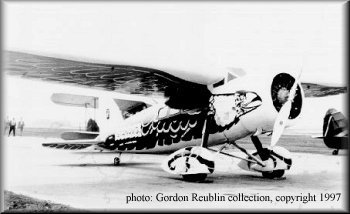 | |
 | The Seversky SEV-3 was the basis for the inter-war Seversky P-35 fighter. Seversky developed a number of trend setting aircraft during the golden age and this same SEV-3 fitted with floats (see inset) set a record for amphibian aircraft in 1935. Flown by Major De Seversky (that is Seversky himself on the aircraft) the plane reached a record speed of
230.4 mph. | |
| The autogyro represented a breakthrough in the development of rotating wing aircraft. Invented by the Spaniard Juan de la Cierva, by 1925 he had proven his concept and went on to develop a number of commercially viable versions. The rotor was actually free wheeling, the engine being used to propel the aircraft forward. The forward motion caused the rotor to spin and develop lift. This autogyro was photographed at the Cleveland airport around 1932 | 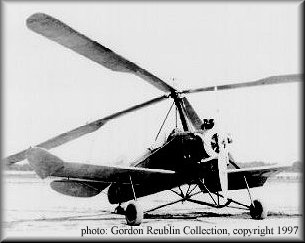 | |
 | The Beech Aircraft Company's model 17, known as the "Staggerwing" is one of the most revered and beautiful civil aircraft to emerge during the golden age. First flown in 1932 she was the progenator of a long line of fast and luxurious civil aircraft. Equipped with a powerful Wright 420 hp engine, with retractable gear and a luxurious interior, the Staggerwing was the "Cadillac" of personal planes during the 30's. | |
| Waco aircraft played a very prominent role in the development of personal aircraft during the 1930s. This Waco QDC, introduced in 1931 represented Waco's bid for business in the four place cabin aircraft category. Only 36 of this type were built but variants of it (models UIC, PCD and UEC) accounted for a substantial number sold during the 30s. |  | |
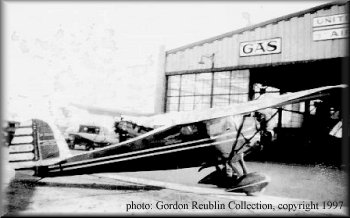 | Another of the seminal aircraft of the 30s was the Monocoupe. Concieved in 1927, they were a sensation due to their comfortable cabin and high performance. Over the years a number of excellent Monocoupe designs were popular during the 30s and 40s including this model D-145 fitted with a Warner 145 hp engine. The CAA owned fifteen D-145s and some were owned by prominent citizens and aviators of the period including Charles Lindburgh and tobacco king R.C. Reynolds. | |
This page updated Dec 26, I will try to get things up, running and interesting in short order.
 |  |
 |  |
 |
Email me, I'd love to hear from you rreublin@yahoo.com
This page hosted by ![]()
Get your own Free Home Page